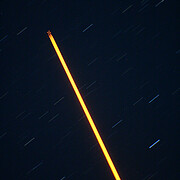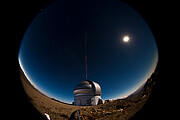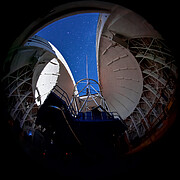Gemini South Shines First Sodium Laser “Constellation”
Gemini Observatory Media Advisor
26 January 2011
In the early morning of January 22, 2011 at 4:38am, Chile Summer Time, a new era in high-resolution astronomy began with the successful propagation of a 5-star sodium laser guide star “constellation” in the skies over Cerro Pachón in Chile.
The event, captured by a series of remarkable images (Figures 1-3), includes one that clearly shows the five laser-produced stars shining in the sky (Figure 1). This first propagation of the Gemini South telescope laser system marks the beginning of on-sky commissioning for the next-generation adaptive optics system called GeMS or the Gemini Multi-Conjugate Adaptive Optics (MCAO) System. GeMS will allow relatively wide-field imaging at extremely high resolution over an exceptionally large portion of the sky.
Maxime Boccas, who heads the Gemini Observatory’s Optical Systems Group captured the event using a digital camera and 500mm lens as the 50-watt laser, split into five beams, caused sodium atoms about 90 kilometers overhead to glow. The resulting image shows the distinctive 5-point grouping that resembles the pattern on a single die or domino. “The Gemini team has been working very hard for a very long time to get to this point and when I saw those 5 stars shining on the sky through my viewfinder it gave me goosebumps,” said Boccas. The laser guide stars are not visible to the naked eye and require a telescope or good binoculars to spot in the sky, although scattering from the beam in the lower atmosphere is visible as seen in the photos which accompany this release.
“This amazing picture illustrates the culmination of a laser development program that started about 10 years ago,” said Gemini Observatory’s Senior Laser Engineer Céline d’Orgeville who has overseen the laser’s development and spent four sleepless nights on the mountain with the commissioning team (Figure 4) to oversee the successful propagation of the laser. “Our Gemini team and its partners, including the laser manufacturer Lockheed Martin Coherent Technologies, have worked extremely hard over the years to reach this milestone,” d’Orgeville adds. “We can now truthfully say that Gemini is one observatory, two telescopes, and six laser guide stars!” (Gemini North has a lower power 14-watt single laser guide star system that saw first light in 2005 and is a key capability for the Gemini telescope on Mauna Kea, Hawai‘i.)
The entire GeMS system will be integrated and commissioned throughout this year and into next. In 2012 the system should begin providing remarkably sharp images for the study of a wide range of topics ranging from the birth and evolution of stars to the dynamics of distant galaxies. GeMS will “feed” a variety of instruments that work in the near-infrared part of the spectrum and produce images and spectra of objects previously unobservable at this level of clarity due to blurring of light caused by turbulence in the earth’s atmosphere.
MCAO is a revolutionary approach to astronomical adaptive optics. The technique samples the turbulence structure in the atmosphere at several levels and then uses a technique similar to medical tomography to reconstruct a 3-D snapshot of how the atmosphere is distorting starlight. This is then used to shape a series of deformable mirrors to cancel out this distortion. All of this happens about 1000 times a second.
The Gemini system is expected to set the stage for the next generation of large ground-based telescopes which will have mirrors 30-meters in diameter or larger. These telescopes will require the latest adaptive optics technologies to produce images of sufficient resolution given the wide column of air they will observe through.
Notes
This work was funded by the international Gemini partnership funding agencies which include: The U.S. National Science Foundation (NSF), the U.K. Science and Technology Facilities Council (STFC), the Canadian National Research Council (NRC), the Chilean Comisión Nacional de Investigación Cientifica y Tecnológica (CONICYT), the Australian Research Council (ARC), the Argentinean Consejo Nacional de Investigaciones Científicas y Técnicas (CONICET) and the Brazilian Conselho Nacional de Desenvolvimento Científico e Tecnológico CNPq.
Gemini observatory is managed by the Association of Universities for Research in Astronomy, Inc. (AURA) under a cooperative agreement with the NSF. The NSF also serves as the executive agency for the international partnership.
Contacts
Manuel Paredes
Gemini South Telescope
La Serena, Chile
Tel: Desk: +56 (51) 205671
Email: mparedes@gemini.edu
Peter Michaud
Gemini Observatory
Hilo, HI 96720
Tel: 1 (808) 974-2510
Cell: 1(808) 936-6643
Email: pmichaud@gemini.edu
Céline d’Orgeville
Gemini South Telescope
La Serena, Chile
Tel: Desk: +56 (51) 205783
Email: celine@gemini.edu
Maxime Boccas
Gemini South Telescope
La Serena, Chile
Tel: Desk: +56 (51) 205643
Email: mboccas@gemini.edu





